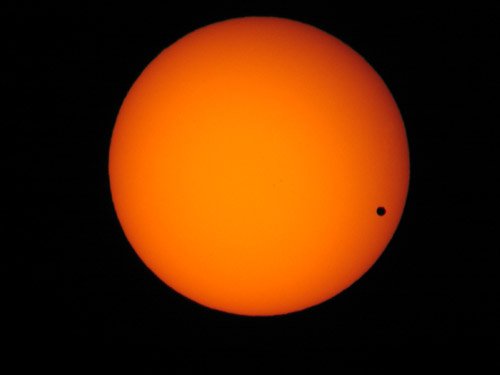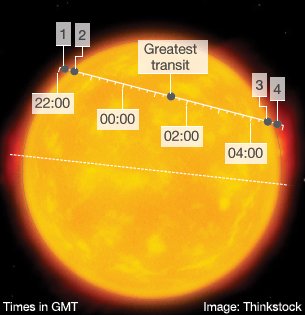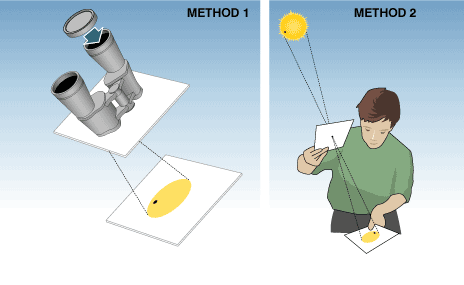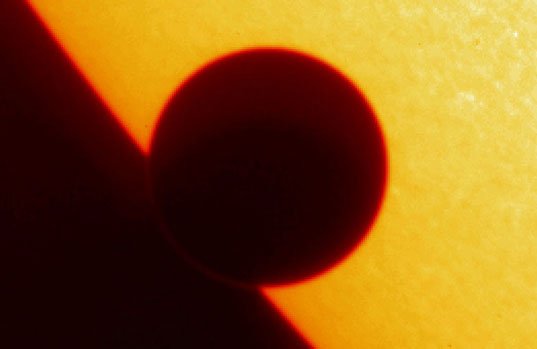Venus has put on a spectacular show for skywatchers by moving across the face of the Sun as viewed from Earth.
Venus transit was a very rare astronomical event that would not be seen again for another 105 years.
Observers in north and central America, and the northern-most parts of South America saw the event start just before local sunset.
The far northwest of America, the Arctic, the western Pacific, and East Asia witnessed the entire passage.
While the UK and the rest of Europe, the Middle East, and eastern Africa waited for local sunrise to try to see the closing stages of the transit.
Venus appeared as a small black dot moving slowly but surely across the solar disc. The traverse lasted more than six and a half hours.
Some of the best pictures of the event were provided by NASA’s Solar Dynamics Observatory, which studies the Sun from a position 36,000 km above the Earth.
“We get to see Venus in exquisite detail because of SDO’s spatial resolution,” said agency astrophysicist Dr. Lika Guhathakurta.
“SDO is a very special observatory. It takes images that are about 10 times better than a high-definition TV and those images are acquired at a temporal cadence of one every 10 seconds. This is something we’ve never had before.”
Many citizens keen to observe the transit first hand attended special events at universities and observatories where equipment for safe viewing had been set up.
In Hawaii, one of the best places to see the whole event, the university’s Institute of Astronomy set up telescope stations on Waikiki beach.
“We’ve had 10 telescopes and the queues have been 10 deep to each telescope all day long,” said the institute’s Dr. Roy Gal.
“It’s a great opportunity to get people excited and teach them stuff. I was hoping for a big turn-out, and it’s been fantastic,” he said.

Venus transit was a very rare astronomical event that would not be seen again for another 105 years
Joe Cali viewed the transit on the edge of the Outback in New South Wales, Australia, another ideal vantage point.
“It is exciting. It may look like just a black dot on the Sun but if you think about it, it’s one of the few times you get to see a planet in motion,” he said.
“But we’ve been improving our chances by connecting with the Shetland Islands and the people up there have done rather better than we have. We’ve been seeing the transit through [a feed] of one of their telescopes,” he explained.
Scientists observed the transit to test ideas that will help them probe Earth-like planets elsewhere in the galaxy, and to learn more about Venus itself and its complex atmosphere.
Venus transits occur four times in approximately 243 years; more precisely, they appear in pairs of events separated by about eight years and these pairs are separated by about 105 or 121 years.
The reason for the long intervals lies in the fact that the orbits of Venus and Earth do not lie in the same plane and a transit can only occur if both planets and the Sun are situated exactly on one line.
This has happened only seven times previously in the telescopic age: in 1631, 1639, 1761, 1769, 1874, 1882 and 2004.
The next pair will not now occur until 2117 and 2125.
The phenomenon has particular historical significance. The 17th- and 18th-Century transits were used by the astronomers of the day to work out fundamental facts about the Solar System.
Employing a method of triangulation (parallax), they were able to calculate the distance between the Earth and the Sun – the so-called astronomical unit (AU) – which we know today to be about 149.6 million km (or 93 million miles).
This allowed scientists to get their first real handle on the scale of things beyond Earth.
Modern instrumentation now gives us very precise numbers on planetary positions and masses, as well as the distance between the Earth and the Sun. But to the early astronomers, just getting good approximate values represented a huge challenge.
This is not to say the 2012 Venus transit was regarded as just a pretty show with no interest for scientists.
Planetary transits have key significance today because they represent one of the best methods for finding worlds orbiting distant stars.
NASA’s Kepler telescope, for example, is identifying thousands of candidates by looking for the tell-tale dips in light that accompany a planet moving in front of its host sun.
These planets are too far away to be visited by spacecraft in the foreseeable future, but scientists can learn something about them from the way the background star’s light is affected as it passes through the planetary atmosphere.
And observing a transiting Venus, which has a known atmospheric composition, provides a kind of benchmark to support these far-flung investigations.
Researchers also took a close look at Venus itself during the transit, used the occasion to probe the middle layers of the planet’s atmosphere – its mesosphere.
They were looking for a very thin arc of light, called the aureole, which can only be seen when Venus appears to just touch the edge of the Sun’s disc at ingress and egress.
The brightness and thickness of the aureole depends on the density and temperature of the atmospheric layers above Venus’s cloud tops.
Observations of the aureole were being combined with data from Europe’s Venus Express spacecraft in orbit around the planet to provide information on high-altitude winds.
The Venusian atmosphere experiences super-rotation. That is – the whole atmosphere circles the planet in four Earth days, on a body that turns around just once in 243 Earth days.
[youtube gB6pTjA-XFc]
[youtube SkRMJWjhv0Q]
Venus is set to move across the face of the Sun as viewed from Earth in a more than six-and-a-half-hour transit, which starts just after 22.00 GMT on Tuesday.
The transit is a very rare astronomical phenomenon that will not be witnessed again until 2117.
Observers will position themselves in northwest America, the Pacific, and East Asia to catch the whole event.

Venus is set to move across the face of the Sun as viewed from Earth in a more than six-and-a-half-hour transit, which starts just after 22.00 GMT on Tuesday
• Times for the start of Venus transit will vary by a few minutes depending on one’s location
• The timings given here are calculated for a viewing position at the Earth’s centre
• Venus is seen to first touch (1) the edge of the Sun’s disc at 22:09 GMT (23:09 BST)
• It is completely on the disc (2) by 22:27 GMT (23:27 BST). The transit lasts over six hours
• Come Wednesday by 04:31 GMT (05:31 BST), Venus is touching the disc’s far side (3)
• At 04:49 GMT (05:49 BST), Venus has left the disc (4). The next transit is on 11 December 2117
[youtube zE0NDEGQQwU]
Venus is set to move across the face of the Sun as viewed from Earth in a more than six-and-a-half-hour transit, which starts just after 22.00 GMT on Tuesday.
The transit is a very rare astronomical phenomenon that will not be witnessed again until 2117.
Observers will position themselves in northwest America, the Pacific, and East Asia to catch the whole event.
METHOD 1: Cut two holes in card for binocular eye-pieces. Push card onto binoculars and fix with tape. Block one lens (with lens cap, for example). Holding binoculars at waist height, angle towards Sun – do not look through them. Move binoculars around until card shadow minimized on viewing surface (piece of white card best). During six-hour transit, move set-up to follow path of Sun across sky, for example by mounting it on tripod or chair.

Observing the Sun with the naked eye or telescope, camera or other optical device, will seriously damage eyesight and may lead to permanent blindness
METHOD 2: Take piece of stiff card and pierce with pin. Hold it up and, looking away from the Sun, adjust angle of card until shadow minimized. Pinhole will project image of Sun into middle of shadowed area. Place another piece of card under shadow and adjust distance to get best picture – more distance gives larger but fainter image. Hole must be clean and as small as possible.
WARNING: Never observe the Sun with the naked eye or telescope, camera or other optical device. Doing so will seriously damage eyesight and may lead to permanent blindness.
Venus is set to move across the face of the Sun as viewed from Earth in a more than six-and-a-half-hour transit, which starts just after 22.00 GMT on Tuesday.
The transit is a very rare astronomical phenomenon that will not be witnessed again until 2117.
Observers will position themselves in northwest America, the Pacific, and East Asia to catch the whole event.
But some part of the spectacle will be visible across a much broader swathe of Earth’s surface, weather permitting.
Venus will appear as a tiny black disc against our star, but no-one should look for it without the proper equipment.
Looking directly at the Sun with the naked eye, or worse still through an open telescope or binoculars, can result in serious injury and even blindness.
It is recommended people attend an organized viewing event where the transit will be projected on to a screen; or they can visit one of the many institutional internet sites planning to stream pictures.
Venus transits occur four times in approximately 243 years; more precisely, they appear in pairs of events separated by about eight years and these pairs are separated by about 105 or 121 years.
The reason for the long intervals lies in the fact that the orbits of Venus and Earth do not lie in the same plane and a transit can only occur if both planets and the Sun are situated exactly on one line.
This has happened only seven times in the telescopic age: in 1631, 1639, 1761, 1769, 1874, 1882 and 2004.

Venus is set to move across the face of the Sun as viewed from Earth in a more than six-and-a-half-hour transit, which starts just after 22.00 GMT on Tuesday
Once the latest transit has passed, the next pair will not occur until 2117 and 2125. Most people alive today will probably be dead by then.
The phenomenon has particular historical significance. The 17th- and 18th-Century transits were used by the astronomers of the day to work out fundamental facts about the Solar System.
Employing a method of triangulation (parallax), they were able to calculate the distance between the Earth and the Sun – the so-called astronomical unit (AU) – which we know today to be about 149.6 million km (or 93 million miles).
This allowed scientists to get their first real handle on the scale of things beyond Earth.
The first person to predict a transit of Venus – the 6 December, 1631, event – was Johannes Kepler, but he died before it occurred.
Jeremiah Horrocks, the young English astronomer, was probably the first to record the phenomenon when he and his friend, William Crabtree, made separate observations of the passage on 24 November, 1639.
By the time the transits of 1761 and 1769 came around, they had become major scientific events. Expeditions were despatched all over the globe to get the data necessary to calculate the AU.
One such expedition was undertaken by Captain James Cook, whose epic voyage in the Endeavour took in the “new lands” of New Zealand and Australia.
Modern instrumentation now gives us very precise numbers on planetary positions and masses, as well as the distance between the Earth and the Sun. But to the early astronomers, just getting good approximate values represented a huge challenge.
This is not to say the 2012 Venus transit will be regarded as just a pretty show with no interest for scientists.
Planetary transits have key significance today because they represent one of the best methods for finding worlds orbiting distant stars.
NASA’s Kepler telescope, for example, is identifying thousands of candidates by looking for the tell-tale dips in light that accompany a planet moving in front of its host sun.
These planets are too far away to ever be visited by spacecraft, but scientists can learn something about them from the way the background star’s light is affected as it passes through the planetary atmosphere.
And observing a transiting Venus, which has a known atmospheric composition, provides a kind of benchmark to support these far-flung investigations.
But Venus itself will come in for scrutiny. Scientists will be using the event to probe the middle layers of the Venusian atmosphere – its mesosphere.
They will be looking for a very thin arc of light, called the aureole, which can only be seen when Venus appears to just touch the edge of the Sun’s disc.
The brightness and thickness of the aureole depends on the density and temperature of the atmospheric layers above Venus’s cloud tops.
Observations of the aureole will be combined with data from Europe’s Venus Express spacecraft in orbit around the planet to provide information on high-altitude winds.
The Venusian atmosphere experiences super-rotation. That is – the whole atmosphere circles the planet in four Earth days, on a body that turns around just once in 243 Earth days.
[youtube p1aAG2TUNY0]




